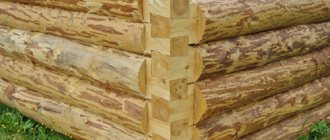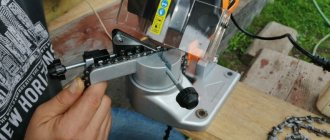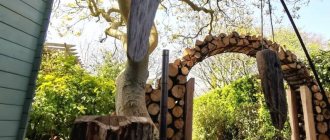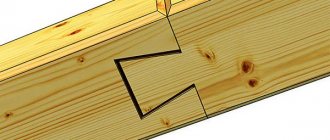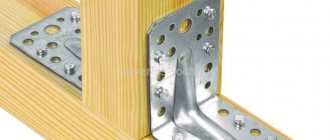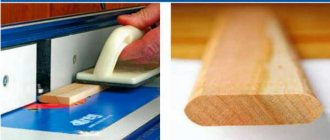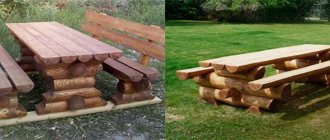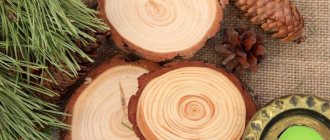Application of dovetail joint
As a rule, this method of fastening is used if there is a need to obtain securely interlocked parts or a solid product at the output.
Here are the most common applications:
- Mechanical engineering production. Dovetails are used to connect elements of compressor devices together. It can also be found in metal cutting equipment and optical instruments.
- Construction works. This method is used to join timber during the construction of wooden cottages. It is also used in carpentry to create window and door blocks, arched structures, partitions and niches.
- Furniture industry. This type of tenon joint is often chosen for fastening frame parts, doors, and drawers. For greater reliability, the joints are additionally glued.
When installing various wooden containers, dovetails are also often used.
Connecting logs in a log house
The construction of log houses using logs is carried out more often than using timber. The connection of logs has technological differences. The requirements for connections are the same - strength and tightness. Let's look at the main ways to make connections along the length and in the corner.
Method of corner connection with the remainder “in the area”
You can connect the remaining logs in the log house using any of the following methods:
- in the region;
- to the clap;
- in a huff.
The first method (“into the cloud”) or “into the bowl” is the simplest. At the same time, a bowl-shaped hole is prepared in the log. Its dimensions must be such that the attached log fits tightly into it. Accordingly, the transverse log must have a bowl or “burl”. Corner connections “in the area” are divided according to the type of execution into options:
- half a tree;
- oval comb;
- in the fat tail.
The most affordable version is a wooden floor bowl. When laying logs, the following must be considered.
- The logs will be stacked more densely if, in addition to cutting out the “obla,” a longitudinal groove is cut along the upper part.
- The groove is filled with flax wool: it will serve as insulation.
- Laying the logs of each subsequent crown is carried out after fixing the transverse logs.
- The strength of the structure is achieved through dowels connecting the upper and lower logs. A dowel is a long wooden dowel with a round or rectangular cross-section.
Connecting logs “in a fat tail”
The fat tail connection is a complex version of the fat tail method. The comb in this case is oval-shaped, and an additional protrusion is placed at the bottom of the bowl, which should be oriented along the log. At the bottom of the recess there is a special recess for the fat tail.
Connecting logs “in a clap”
This connection option is performed similarly to the methods described above. The difference is this. The bowl is cut down at the bottom of the log (with the “in the boulder” method - at the top). To do this, prepare a corner for laying the logs. The end of the previously laid log needs to be slammed down (this is the essence of the method).
Connection "in the okhryap"
With this method, straight recesses are prepared in the upper and lower parts of the log (at the junction), each with a depth of ¼ of the diameter. The method is convenient for use if it is impossible to use other methods of joining logs.
Joining logs in corners without leaving any residue
With this connection method, there is no part of the log protruding beyond the outer perimeter of the wall. For a reliable connection, a “cut” is required: the ends of the logs are fixed with spikes. To prevent the cut from being blown by the wind, the horizontal planes of the cut are made inclined. This connection is called a “dovetail”: the wedge-shaped part of one log is wedged between two inclined planes. If it is necessary to attach a partition to the wall, a T-shaped connection is made. The end of the partition log is given the shape of a truncated cone, at the base of which is a square. The outer part of the cone is expanded. A similar recess is cut out in the corresponding part of the wall. The connection will be reliable due to the jamming of the parts.
Types of dovetail joints
Today, many different types of fastenings have been developed. To determine the variety of swallowtail, a view from above is necessary. Possible options will be discussed below.
- A rough connection is distinguished by good visibility of the connecting parts. In the hidden version, the body of one part masks the teeth of the second. The through type of fastening involves the tenon covering the entire width of the second element. When choosing a one-sided tenon, only part of it is removed, and the other side is not touched.
- Dovetails can vary not only in appearance, but also in the size of the grooves and teeth. The technical documentation contains information on a scale that combines key dimensions of individual coupling parts.
For the rough variety, a scale of 1 to 5 is used. It is recommended for soft wood and allows you to reliably connect even large parts. If hard wood is used, then it is better to choose the 1 to 8 option. In this case, the joints will look more attractive.
Butt joint of timber
Butt fastenings are the simplest type of connection; the workpieces are fastened at right angles using construction staples or standardized fasteners; the building material is not processed. The technology is used in the construction of temporary buildings, field storage facilities and sheds, and arrangement of work sites. The structures are easy to disassemble, and the lumber can be reused many times.
With the advent of new generation woodworking equipment and laminated lumber, the technology has received innovative development. To strengthen the fastening, a hidden tongue-and-groove lock and a trapezoidal key are used. The castle was called the root thorn; the shape and dimensions of the castle were standardized. The groove and tenon are made on modern milling machines, the reliability of fastening is ensured by high precision processing of workpieces. In such a lock, the tenon is securely fixed inside the workpiece.
Special requirements are imposed on the quality of the material; this method of installing timber is used when working with kiln-dried laminated wood. The corners of cottages and luxury housing are fastened to a secret tenon; the technology is used in the design of facades, interiors, furniture manufacturing, the main advantages of fastening:
- The structures are easy to assemble and disassemble; you can purchase an industrial house disassembled and assemble it yourself;
- The corners of buildings are durable and airtight; this method of assembling corners is called a “warm corner”;
- The front side is not processed, the uniformity of the wood texture and the absence of cuts make the façade of the building attractive;
- The fastening can be strengthened with construction adhesive.
For beginners, the easiest option is to connect profiled timber using the butt method. The ends of the beams are cut evenly and fixed at the corners using steel brackets or plates with spikes.
Butt connection of beams
To strengthen corners assembled end-to-end, dowels are often used - vertical rods made of hard wood (oak, birch, hornbeam).
Joining timber on a straight flat key (dowel)
The optimal joining option is the “warm corner” method, also called the “root tenon” connection. At the end of the beam, an internal protrusion-spike is cut out, which protects the seam from blowing and increases the strength of the corner.
A common corner joint method is the dovetail. It differs from the root tenon in its trapezoidal shape, which makes the contact area of the beams denser and more rigid.
Algorithm for making a connection
A dovetail is quite easy to create if you do all the necessary preparatory work in advance. Mechanical experience will also not be superfluous, because the product must be strong and beautiful.
Tools
To make a corner connection, you should prepare:
- board;
- Beam;
- Wood glue.
If you need to join the outer corners of the house, then experts advise purchasing also a sealant for additional processing of the gaps.
To make tenons and grooves, you need:
- Square;
- Knife;
- Set of chisels;
- Crafting table;
- A saw suitable for the desired type of fastening;
- Hammer;
- Sander.
If you plan to use a connection on large elements, for example, when constructing a building, then it is recommended to make a series of calculations, select the appropriate type, determine the number of tenons, the angle of inclination, etc.
Literature
- [www.mathnet.ru/php/getFT.phtml?jrnid=intf&paperid=41&what=fullt&option_lang=rus Arnold V.I.
Theory of disasters, - Any edition.] - Arnold V. I., Varchenko A. N., Gusein-Zade S. M.
Features of differentiable mappings, - Any edition. - Brus J., Giblin P.
Curves and singularities: A geometric introduction to the theory of singularities, - M.: Mir, 1988. - Arnold V.I.
Features of caustics and wave fronts, - M.: Phazis, 1996. - [www.mathnet.ru/php/getFT.phtml?jrnid=intf&paperid=40&what=fullt&option_lang=rus V. I. Arnold, V. S. Afraimovich, Yu. S. Ilyashenko, L. P. Shilnikov.
Bifurcation theory.]
Work progress (step by step)
Before you begin, you need to mark all the blanks with a pencil.
The order of steps to create a dovetail is:
- Mark the tenons using a square. It is recommended to mark the parts that will need to be removed with a saw in color.
- Carefully cut out the thorns.
- Remove waste. You can use a jigsaw or a chisel.
- Mark the dovetails. It is recommended to place the element with tenons on a prepared piece of wood so that its end part coincides with the line of the shoulders. Only then can you begin to apply markings.
- Carry out sawing work. Remove waste, trim allowances and clean up.
- Join the parts to check the tightness of the fit. If necessary, remove excess with a chisel.
- Glue the connected elements together and clamp them with a clamp, having previously placed wooden strips so that the load is distributed evenly.
It is more convenient to make a dovetail using a manually driven framer. In this case, the quality of the finished product will be much higher, and it will take much less time to manufacture.
Overview of the main bracket manufacturers
Domestic brackets
| ECT Tula Research and Production produces a huge range of brackets for domestic shotguns:
More information about the EST model range |
| Rose of Wind Volzhsky produces all-milled side brackets for AK family shotguns and Weaver steel rails for Czech and Italian shotguns. Due to the use of durable materials, the cost of the brackets is not small, but when compared with foreign analogues, it is significantly cheaper. Windrose brackets are professional solutions for installing night and thermal imaging sights with a unique clamping system.
Read more about the “Wind Rose” model range |
| VOMZ The Vologda Optical-Mechanical Plant produces a number of brackets for installing its sights. VOMZ brackets have a budget price, which is why they have gained popularity among hunters. Separately, there is a series of side brackets with a top part for Weaver or rings.
More information about the VOMZ model range |
German brackets
| Kilic Feintechnik (MAK) The Kilic Feintechnik company is one of the leaders in the number of products produced in the field of weapon mounts. German brackets under the MAK brand are distributed throughout the world. The company's products allow you to solve any problems related to the installation of day, night and thermal imaging sights. Many optical manufacturers cooperate with this company and produce specialized kits.
More information about the MAK model range |
| Recknagel The German company Recknagel has a wide range of products from simple rings for hunting rifles to balanced and adjustable monoblocks for tactical applications. The patented ERA TAC series has proven itself to special forces as a durable and reliable fastener.
Read more about the Recknagel range |
| Apel One of the most popular quick-release fastening systems is produced by the German company Apel. The company is considered one of the oldest in the fastening manufacturing market and has gained its fans over the years. Our own system of rotary mounts, high quality workmanship, specialized rails and brackets for certain brands of sights.
Read more about the Apel lineup |
Italian brackets
| Contessa Alessandro When it comes to installing mounts on sophisticated types of weapons, then hunting enthusiasts choose Italian Contessa mounts. The company develops high-strength adapter strips and brackets for all types of foreign guns.
Read more about the Contessa range |
American brackets
| Leapers The Leapers company occupies a high position in America in the sale of weapons tuning products. The model range includes rings, monoblocks, brackets for handguards and quick-release fasteners. Due to the presence of our own factory in China, the cost of products will please every hunter. In our store you will find all Leapers mounts, including the Accushot series quick-release rings and side brackets for the AK family.
Read more about the Leapers lineup |
| Leupold One of the most recognizable American manufacturers of optical sights, Leupold, offers various options for steel and aluminum rings. Leupold has its own designs of quick-release and swivel brackets for foreign shotguns.
Read more about the Leupold lineup |
| NightForce NightForce produces sights for tactical tasks and competitions, and as an addition offers its own brackets that provide high installation strength. Basically, NightForce mounts are seating rings with different mounting heights.
More information about the NightForce lineup |
Czech brackets
| Kozap Kozap is a private company in the Czech Republic that produces mounts primarily for Czech rifles. The assortment includes separate and monoblock rings, quick-release rotary kits and landing strips. Kozap brackets are affordable in price compared to analogues, while being quite durable due to the use of steel as a material.
Read more about the Kozap lineup |
Swedish brackets
| Spuhr Swedish Spuhr brackets are a separate branch in the fastening market. The company specializes in accessories for precision shooting. The brackets have high precision, a certain degree of inclination and levels. If the task is to place a bullet in the center of a target at a long distance, then professionals choose Spuhr quality.
Read more about the Spuhr lineup |
Pros and cons of dovetail joints
pros
This joining method for cladding and thermal insulation of the walls of a wooden building has the following advantages:
- Less wood waste;
- Significant expansion of the interior space of the house;
- The evenness of the corners makes it possible to cover the walls with siding, clapboard or gypsum board;
- Maximum adhesion reliability among all types of connections;
- No need to use hardware products;
- Low cost of construction work.
In addition, the dovetail serves as an excellent protection against moisture penetration into the home. It is also worth noting a number of other advantages:
- Preservation of wood structure;
- No natural deformation of the material;
- Possibility of adjusting the fastening power;
- Increasing the strength properties of the product.
Minuses
The connection has only two disadvantages:
- Closed corners negatively affect resistance to temperature changes, which means there is a high probability that mold will grow on the surface of the wood. The solution is to lay waterproofing or treat it with special compounds.
- Making fastenings requires the master to have skills, which makes it impossible for a beginner to build a house with his own hands.
Dovetail is practically the most effective way of attaching wooden elements to each other. The spikes and teeth cannot be separated from each other even without glue. In addition, such a connection looks very decorative.
Thanks to these advantages, this joining method is used in many areas, from construction to mechanical engineering. It is also used in applied arts.
Do-it-yourself half-tree corner joints
Half-timber corner notch (overlapping) is the most common type of frame connection. Its logic is extremely simple: at the ends of both parts, recesses (folds) are cut out along the width of the counter part. The fold forms an edge and a shoulder - they must be perfectly smooth and strictly perpendicular to each other. In a high-quality connection, the surfaces of both parts fit tightly and form a joint without the slightest gap.
You can read about methods for precise fitting of carpentry joints in an article devoted to this topic.
Connection marking
Create markings for the fold selection. To do this, use a carpenter's square, a surface planer and a marking knife.
Measure the length of the edge along the width of the mating part. Draw marking lines on the edges. Set the thicknesser to half the thickness of the part and make side markings.
Advice! When creating carpentry joints yourself, use a sharp marking knife instead of a pencil. It will ensure high marking accuracy and the absence of marks on the finished part. In this case, the deepened line will become a convenient starting position for a chisel or auger saw.
Rebate cutting
Using a back saw, saw off the waste part on each part, carefully following the markings without strong pressure or jerking.
